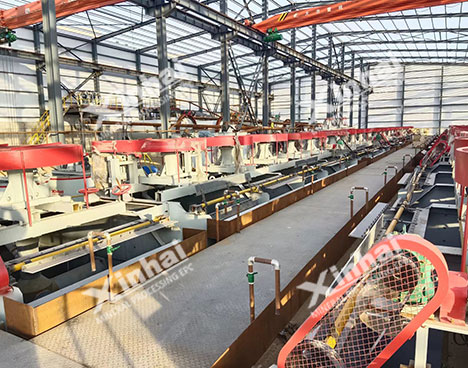If you want to know more information (such as product/process price, etc.), please contact us 24-hour telephone
Gold in quartz usually exists in the form of very small particles and is closely symbiotic with other minerals. Therefore, the separation of gold from quartz has higher requirements on process and equipment, which requires a set of complex and fine process flow, advanced and applicable modern equipment to realize the efficient separation and extraction of gold.
1.1 Crushing pretreatment
Adopting three sections and one closed-circuit crushing process, configured with jaw crusher for coarse crushing and cone crusher for medium and fine crushing, the quartz ore will be crushed to -25mm particle size range. Through the screening closed-circuit system to realize particle size control, to provide qualified feed for the grinding process.
1.2 Milling and dissociation process
Semi-autogenous grinding + ball mill configuration, through precise control of grinding concentration (65-75%) and media filling rate (28-32%), grinding materials to -200 mesh accounted for more than 85% of the fineness. Equipped with hydrocyclone to form a closed-circuit system, to ensure that the gold particles to achieve full monomer dissociation, the degree of dissociation reaches more than 98%.

2.1 Optimization of pharmaceutical system
Construct the composite pharmaceutical system of selective trapping agent (pentoxifylline) + foaming agent (MIBC) + adjusting agent (sodium carbonate). Through the online pH monitor (control range 8.5-9.5) and automatic dosing system, the best hydrophobicity regulation of gold surface is realized.
2.2 Flotation equipment configuration
Inflatable mechanical agitation flotation unit (XCF/KYF type) is used in combination with flotation column. The rougher section is equipped with 6 tanks and 50m³ flotation machine, the finer section adopts 3m diameter flotation column, and 4 tanks and 30m³ flotation machine are set in the sweeping section to form a high-efficiency sorting circuit.
3.1 Thickening and dewatering system
Adopt high-efficiency deep cone thickener (Φ15m×10m) to carry out gravity settling, and the concentration of bottom stream is upgraded to 55-60%. Equipped with automatic unloading device and flocculant automatic adding system, the processing capacity reaches 120t/h.
3.2 Filter-drying process
Choose chamber-type high-pressure diaphragm filter press (XMZ300/1500), working pressure 1.6MPa, cake moisture ≤ 18%. Supporting hot air drying system (200 ℃) to make the final concentrate moisture content down to less than 8%.
4.1 CIP/CIL process selection
Configure the carbon leaching tank (CIL) system according to the ore characteristics: 8 sets of Φ5.5m×6.5m tandem leaching tanks with activated carbon density of 15g/L. Adopting multi-stage countercurrent adsorption design, the gold adsorption rate is ≥98.5%, and gold-carrying charcoal grade is up to 3,000g/t.
4.2 Activated carbon management
Establish thermal regeneration system (rotary kiln 650℃) and acid washing regeneration device to maintain the adsorption capacity of activated carbon above 95%. Configure carbon density control system (γ-ray detector) to realize dynamic balance.
5.1 Leaching parameter control
Adopt hydrogen peroxide-enhanced cyanidation process, maintain NaCN concentration at 0.03-0.05% and dissolved oxygen at 8-10 ppm, configure online ORP detector (control range -200~-300mV) and automatic cyanide replenishment system, and stabilize the leaching rate at over 94%.
5.2 Safety and environmental protection measures
Implement three-level cyanide monitoring system, equipped with HCN gas alarm device and emergency neutralization pool (sodium hypochlorite reserve). Adopt countercurrent washing-zinc powder replacement closed-circuit process, with tail liquid CN-concentration ≤ 0.2mg/L.
Note: The designed processing capacity of this process is 3000t/d, the total gold recovery rate ≥92%, and the purity of the final gold ingot reaches more than 99.99%. Each section is equipped with DCS control system to realize real-time optimization and adjustment of process parameters.
Solid-liquid separation is carried out for the leached slurry to remove the solid residue and get the solution containing gold. Solid-liquid separation equipment, such as centrifuges, filters, etc., completely separate solid particles from the gold-containing solution by means of physical separation to ensure the maximization of gold retention in the solution.
Gold-containing solutions are extracted through the process of electrolytic deposition. In the electrolytic cell, gold ions are deposited on the cathode as pure gold. The electrolytic deposition process requires precise control of current, voltage, electrolyte composition and other parameters to ensure the quality and purity of gold deposition.
Electrolytic deposition of gold usually contains impurities, the need to remove impurities through the refining process, to get high purity gold. Refining methods include smelting, chemical refining, etc., through high-temperature smelting and chemical reactions to further remove impurities in the gold, and ultimately get in line with market standards of high purity gold.
After the above eight steps, gold can be extracted from the quartz, in actual production, should be based on the results of mineral processing test process design and equipment selection, scientific process and equipment specifications, can make the gold extraction process twice as much with half the effort.